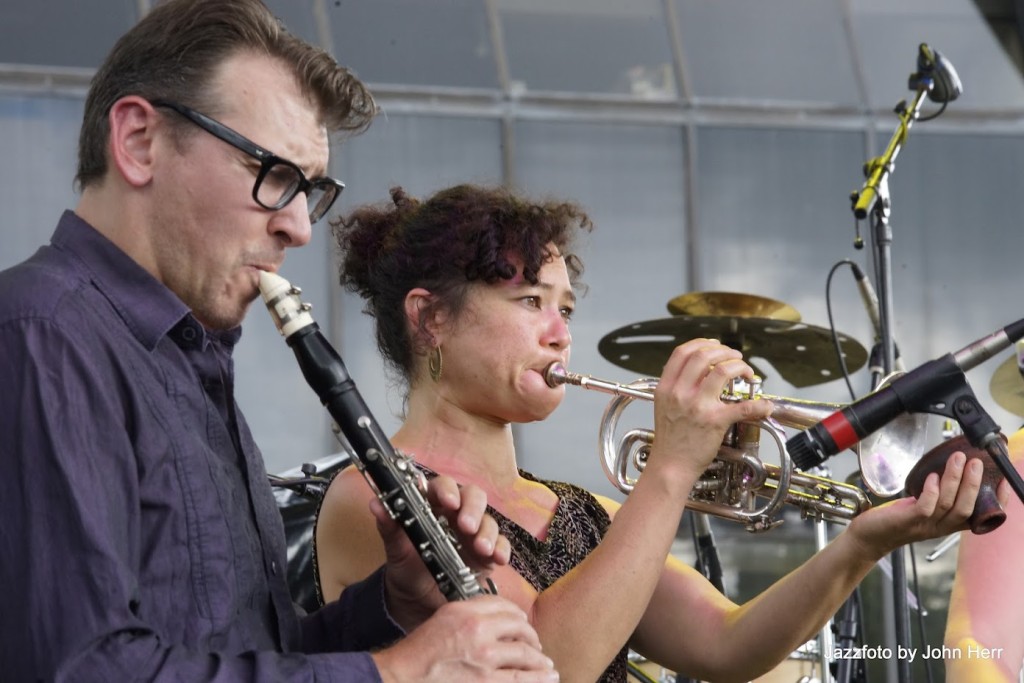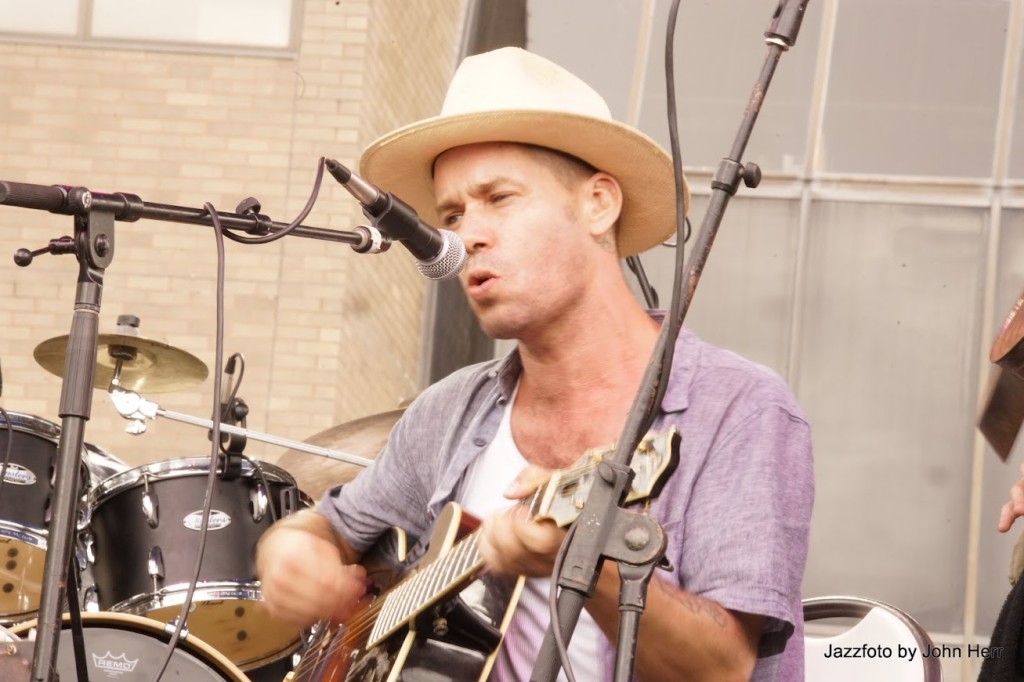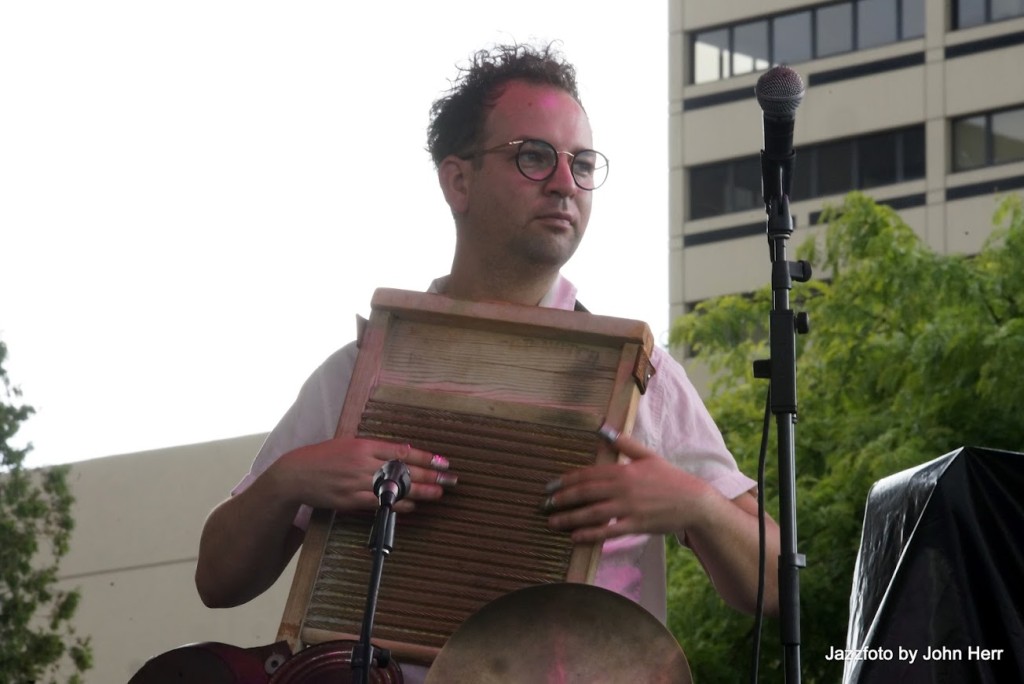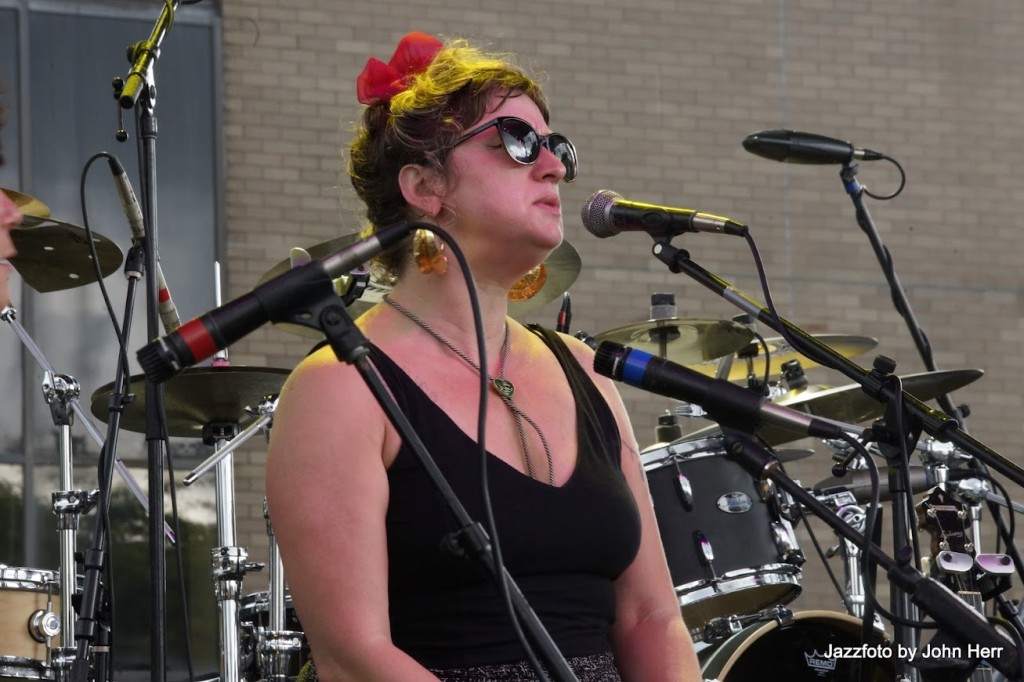The New Orleans’ street-sensation Tuba Skinny took the Amazon Main Stage Saturday, June 24 under rainy skies at the at the 37th edition of the National Grid Syracuse Jazz Festival in downtown Syracuse, NY.
The band, however, was without one of its founders, trombonist Barnabus Jones. Turns out the talented tailgator had simply missed his flight north that morning.
But of course, as one-third of the traditional frontline, the ’bone is a crucial element of the combo’s Dixieland-inspired sound. So in Jones’ absence, cornetist Shaye Cohn and clarinetist Jonathan Doyle both had to work just a little bit harder than usual.

No problem. The always-solid Shaye honed in on the head while coaxing Jon to improvise with carefree abandon. Tunes such as the opener “Too Much Competition,” Ma Rainey’s “Oh Papa Blues,” and “San” a la Johnny Dodds all soared to the sounds of Shaye’s brass bolstered by Jon’s reed.

Precipitation began pelting the crowd st 5:30 pm, as the band made its first-ever appearance in the Upstate NY city. Reedman Doyle was subbing for regular Tuba Skinny clarinetist Craig Flory, who—like Jonathan—is also a native of the Great Northwest, the state of Washington, to be precise.
In Syracuse, Tuba Skinny guitarist Greg Sherman ably vocalized several swingin’ numbers such as Tarheel Slim’s 1953 cheatin’ tune “Too Much Competition” and Memphis Slim’s 1948 chart-topper, “Messin Around.”
Over the years, Tuba Skinny has never been afraid to bend genres, and has routinely dabbled in old-time country, rockabilly, and even bluegrass numbers. On June 24, Sherman evoked a twangy Riley Puckett with “What Is the Reason I’m Not Pleasin’ Ya” featuring a lively tuba break by Todd Burdick.

Speaking to the audience between numbers, Shaye Cohn noted that the rainfall was diminishing yet she admired the colorful panorama of umbrellas filling Clinton Square.
And suddenly the sun burst forth, but even with sunlight filling the square the rains again let loose.
Later, the band paid homage to the high lonesome sound with its version of “All Night Long Blues” first waxed by Burnette & Rutherford in 1927. Guitarist Max Bien-Kahn, plucking a resonating instrument, gave such tunes an authentic rural ambiance as did banjoman Jason Lawrence.
Similarly, washboard player Robin Rapuzzi impressed the crowd with his carefree jug band percussion, fingering amazing, ear-catching rhythm breaks on “San” and “Shake It and Break It,” Charley Patton’s kinetic 1930 hit.

Gotta wonder why the band eschewed vocals for its instrumental version of the Washboard Rhythm Kings’ “Hummin’ to Myself” from 1932. The song is fully titled “(I’ve Got the Words, I’ve Got the Tune) Hummin’ to Myself” but neither of Tuba Skinny’s best singers gave voice to those lovely lyrics. Oh, well, the band still reveled in the tune’s pulsating rhythms and wistful melody.
Six-stringer Sherman sang lead on Tampa Red’s long-lasting 1940 hit, “It Hurts Me Too,” while the chorus was reinforced by Erika Lewis’s harmony vocal.
Lewis’s presence on the bandstand was much-appreciated by fans who’ve been confused about her recent whereabouts. Several years ago, Erika relocated from New Orleans to North Carolina. So she no longer performs with Tuba Skinny on a regular basis, however, she still tours with them and joins them for major festivals such as the Syracuse event.
Even in the company of Tuba Skinny’s extraordinary instrumentalists, Erika—who doubles on bass drum—managed to steal the show with her crystalline vocals, sultry stage presence, and sparkling charisma. She proved it again and again in downtown Syracuse on tunes such as Sara Martin’s plaintive break-up ballad from 1925, “Forget Me Not Blues,” and Bessie Smith’s “You’ve Got to Give Me Some” from 1928.
Erika boldly delivered the suggestive “bread and meat” allusions in “How Do They Do It That Way,” the Okeh side that Victoria Spivey made in 1929 with Red Allen’s Orchestra.
With her hair pulled back and topped with a red bow, Erika Lewis sported gold-looped half-moon earrings, a green heart nedallion necklace, and a pair of Blues Brothers-syle shades. Wearing a low-cut black blouse over a red-and-black skirt, Erika poured passion into two songs by the little-known Georgia-bred, Chicago-based songbird Georgia White, “Daddy, Let Me Lay It on You” and “I’m Blue and Lonesome.”

For one miraculous moment during the “Lonesome” chorus, Erika’s voice and Shaye’s cornet line melded seamlessly into one. It was a simple, sweet harmony, of course, but it was also something more. A meeting of the minds. A symphony of the souls. A rich rediscovery.
Appearing on the Syracuse Jazz Festival’s Amazon Main Stage under persistently rainy skies, Tuba Skinny’s hour-plus set of classic jazz was followed a boppish local jazz combo and then by fusion forefathers Spyro Gyra. Later that night, pop vocalist Gladys Knight closed the show.
Russ Tarby is based in Syracuse NY and has written about jazz for The Syncopated Times, The Syracuse New Times, The Jazz Appreciation Society of Syracuse (JASS) JazzFax Newsletter, and several other publications.






















